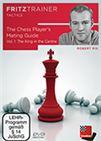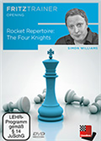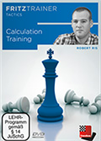Calculation training by Robert Ris
A review
Over the years I continue to hear the word "talent" to describe a player who is good. However, I'm constantly looking for ways to quantify how good someone is, based on something more tangible. I'm inspired, ironically, by reading about the French Revolution. It seems neither the king nor the revolutionaries were able to rule or even play chess — no matter how much talent they had — once their heads were cut off.

This observation brings us to the next: If the magical "talent" resides in the head of a person, then we know it must be related to something they do with their brains. Finally, we arrive at the idea of chess training — because no champion became such without training very hard. There is the famous myth that Capablanca didn't work on his chess when, in fact, he left his university studies in order to focus solely on the game. Or that Alekhine, in order to beat Capablanca in the world championship, had to work really hard on training too!
Let's not neglect to mention other "legendary talents" who were working on chess all day long; we all know their names: Tal (often studying 50 to 60 games a day!), Fischer studying all day and playing blitz all night, Kasparov whose intensity on training amazed Polgar, etc. Practically none of the champions we all consider the best, actually sat down on the sofa watching TV, letting the innate talent do the job for him. They were training hard all day. Some had coaches. They played chess all the time. I guess it's not a surprise to see their brains devote neurons, and creating synaptic connections especially dedicated to chess.
 One of the first lessons you learn in chess is to bring your king into safety by castling – be it on the kingside or the queenside - after having developed your minor pieces. By ignoring this rule of thumb, not only may your king end up in trouble, but your other pieces and in particular, your rooks, may never end up playing much of a role, and before you know it, things are looking grim. Even at the highest level, the consequences of neglecting this basic element of opening theory has been frequently underestimated. In this first volume of the new Mating Guide series, the emphasis will be on how to exploit a vulnerably placed king in the centre. A must-have for ambitious chess players who want to improve their own attacking skills.
One of the first lessons you learn in chess is to bring your king into safety by castling – be it on the kingside or the queenside - after having developed your minor pieces. By ignoring this rule of thumb, not only may your king end up in trouble, but your other pieces and in particular, your rooks, may never end up playing much of a role, and before you know it, things are looking grim. Even at the highest level, the consequences of neglecting this basic element of opening theory has been frequently underestimated. In this first volume of the new Mating Guide series, the emphasis will be on how to exploit a vulnerably placed king in the centre. A must-have for ambitious chess players who want to improve their own attacking skills.Many factors which make us good in chess are related to memory, visualization, passion for the game. However, the main factor — once we have learned the basic tactics and common checkmate patterns — is of king's importance for winning games, and this factor is called "calculation."
Robert Ris, an outstanding coach, has been involved in creating DVDs for teaching basic, and fundamental tasks to amateurs and club players, particularly interesting were the one entitled mating guide.
 This DVD, as stated by Ris in the beginning, is aimed to answer the following fundamental questions:
This DVD, as stated by Ris in the beginning, is aimed to answer the following fundamental questions:
- How do the pieces work together?
- How should I spend my time over the board?
- Which lines should I calculate? Which are not important?
- What are effective calculation training methods?
- How do we choose the right candidate move(s)?
The DVD has been divided into three parts:
- Forcing moves
- Method of elimination
- Imagination
These three parts are followed by a testing section and three databases.
One database of games (64 games) from which comes the following interesting game:
 Like a fine wine, the Four Knights only improves with age, establishing itself as an extremely effective way of meeting 1...e5. On the outside this opening seems deceptively quiet, yet apparently natural moves can often lead to some devastating attacks.
Like a fine wine, the Four Knights only improves with age, establishing itself as an extremely effective way of meeting 1...e5. On the outside this opening seems deceptively quiet, yet apparently natural moves can often lead to some devastating attacks.Another database with calculation examples (fifteen — which are based on the video lectures), and one with calculation exercises (ten based on the test video clips). Videos and tests are for a total of nearly five hours! Yes, you have an International Master working with you for five hours on your calculations! This is quite amazing if we think that just a few years ago the only possibility was to read a book, and now we can have someone explain step-by-step what to watch in a position, and how to calculate the different lines.
Let's begin with the forcing moves, what are the questions we should ask ourselves?
Look at checks, captures, and if it is possible to create new threats.

What about elimination? Two moves look both interesting, but how to choose the right one? The last part, dedicated to imagination, is designed to help the player to think outside the box. When one is not only reacting to the opponent's threats but actively generating ideas.
IM Ris says he uses the examples in this DVD for players who are rated from 1600 to 2200, from his practice as a coach, so the positions have been tested under a lot of different ratings.
During the DVD, Ris gives the viewer a thought-map of what he does when he is presented with a position. To internalize such thought-process means to gain rating points and time on the clock!
I give here some of the steps, but obviously one should watch the videos, with the positions prepared by Ris, because it will light up a lamp in our brains, and create memory associations which we will be able to use also in our games:
- Check the material balance
- Piece activity (and one needs to know his own active/inactive pieces, as well those of the opponent)
- Opponent's threats (how dangerous are they?)
- What are the weaknesses in our position?
While watching the videos I made some associations with other games I've seen. My reviews are written from an active tournament chess player point of view, and aimed at other chess players who truly want to improve. Hence I'd like to share a diagram, proposing a small exercise, and then show the entire game for those who want to check the goodness of their analysis. I annotated the game without an engine (as Caruana says: Engines can become crutches...while I want to walk and fall with my own legs!) mainly because in a tournament game, engines are not allowed, so all mistakes in the analysis are mine.
 This DVD emphasizes the importance of training your calculation skills. Dutch IM Robert Ris made a selection of training material which he uses in lessons with students ranging from 1400 to 2400.
This DVD emphasizes the importance of training your calculation skills. Dutch IM Robert Ris made a selection of training material which he uses in lessons with students ranging from 1400 to 2400.
White just played 26.Na7 attacking the Rc8 and the Bd5, what would you play as Black?
Here the game:
Final Thoughts
I was amazed at the examples Ris found for the section forcing moves, because they have a lot of lines to calculate, and most of them continue to exercise the student on asking those questions we have outlined above. In this DVD one can truly see why Chess is important for the young. They are taught how to think systematically about a position, and I wish such thought-process would be taught in schools because it would surely help the students to have a better future.
Links
























